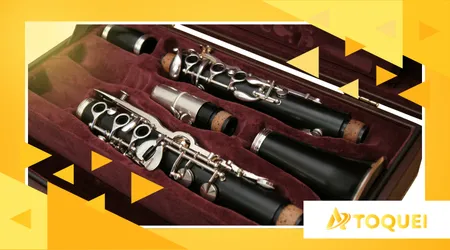How to properly clean and maintain a clarinet

The art of clean and maintain a clarinet correctly is a fundamental pillar for any instrumentalist, from student to professional.
Advertisements
This care not only preserves the aesthetic beauty of the instrument, but directly impacts the sound quality and the precision of the mechanics.
Neglecting routine maintenance is, unfortunately, a common mistake.
The Vital Importance of Post-Use Cleaning
After every practice session or concert, saliva and moisture are your biggest enemies. These residues, if not removed, can cause serious damage.
Excessive moisture leads to wood swelling and key corrosion.
Advertisements
Why is Humidity the Main Threat?
The eyelet is the main source of moisture during performance. The pavilion and bell, in particular, accumulate condensation quickly. Prompt cleaning prevents premature deterioration of the shoe.
Wood, especially ebony (granadilla), is porous and absorbs moisture. Over time, this unregulated absorption can lead to cracks. Attention to internal cleanliness is crucial.
Read more: How to Choose Drumsticks: A Complete Guide
It is essential to use the cleaning cloth (or swab) immediately after playing. It should be carefully passed over all sections of the clarinet.
Essential Wood Care (Body)
The instrument's structure, usually made of wood, requires special attention. It needs nourishment to maintain its integrity and resonance. Lubrication is a delicate but necessary process.
The Power of Bore Oil
The use of bore oil (Internal bore oil) is recommended periodically. It helps replenish the natural oils lost by the wood. This procedure prevents the wood from drying out and cracking.
A good example is the Buffet Crampon grenadilla clarinet. If not oiled properly, the chances of cracking increase exponentially. This procedure should be done sparingly.
++ Alto Saxophone vs. Tenor Saxophone: Which Is Better for Beginners?
Excessive oil can actually attract dust and dirt. Apply lightly and evenly, and maintain the ideal frequency.
| Suggested Frequency | Component | Action |
| After each use | Internal Orifice | Use a cleaning cloth (swab) |
| Every 2-4 weeks | External Wood | Cleaning with a soft, dry cloth |
| Every 1-2 months | Internal Orifice | Light application of bore oil |
The Mechanics of Wrenches and Slippers
The key system is complex and vital to tuning and playability. The pads, which seal the holes, are the most vulnerable. They can become sticky and tear easily.
++ How to choose the first acoustic drum kit for beginners
Sneaker Maintenance
For sticky shoes, using a special cleaning paper is recommended. Simply insert the paper and gently press the key. Never pull the paper out while the key is pressed.
Dirt buildup on springs and axles hinders movement. Lubrication with a light oil specifically for switches is essential. This ensures quick and quiet action.

According to National Association of Music Educators (NAfME), 75% of clarinet tuning problems are linked to worn or leaking pads. This underscores the need for constant attention.
Imagine the mechanics of the clarinet as a well-rehearsed orchestra. If one player (key) is slow or out of tune (sticky), the entire performance (sound) is compromised.
Maintenance is the daily rehearsal of this orchestra.
++ Complete Guide: How to Clean and Maintain a Clarinet
Smart Storage Techniques
Where and how the instrument is stored is as important as cleaning itself. The external environment directly influences conservation. Temperature and relative humidity are critical factors.
The case should be of good quality and rigid to protect against impacts. Never store the clarinet disassembled for long periods.
A practical example:
A musician in Curitiba, where humidity is high, should use desiccant sachets in the case. A musician in Brasília, with its dry climate, needs humidifiers for instruments. Adaptation is key.
The Question of Relative Humidity
The ideal moisture content for clarinet wood is between 40% and 60%. Outside this range, the risk of structural damage increases.
How can we expect sonic excellence if the very home of sound is at risk? It's a rhetorical question.
To the clean and maintain a clarinet correctly, you protect your investment.
Conclusion: Commitment to Sonic Excellence
By adopting a rigorous and smart routine, you will be doing more than just clean and maintain a clarinet correctly.
You will be investing in your art and the longevity of your instrument.
Attention to detail, such as how often to oil and clean your pads, is what separates a careful player from a negligent one.
Remember, the instrument is an extension of your musical voice, and deserves the best treatment.
To the clean and maintain a clarinet correctly, you ensure that every note is played with the clarity and resonance it deserves.
Frequently Asked Questions
What oil should I use on a wooden clarinet?
A bore oil specifically designed for wind instruments should be used. Reputable brands offer oils based on purified vegetable oils (such as almond oil) or synthetic oils, which are more stable.
Avoid household oils, as they can damage the wood.
Is it normal for the clarinet to crack?
No, it's not normal, but it can happen. Cracks usually occur due to sudden changes in temperature or humidity.
This is common when a cold instrument is heated quickly, or vice versa. Therefore, when clean and maintain a clarinet correctly, avoid thermal shocks and keep it at a stable humidity.
Should I clean the mouthpiece?
Yes, the clean and maintain a clarinet correctly includes the mouthpiece. The mouthpiece (and the reed) accumulate saliva and bacteria.
Wash the mouthpiece with cold water and mild soap after each use, rinsing thoroughly. Never use hot water, as it can warp the material, especially if it's ebonite.
The reed should be gently cleaned and dried.
How often should I send my clarinet to a luthier?
It is recommended to have a complete maintenance by a professional luthier at least once a year.
The luthier can check for leaks, replace worn pads and corks, and align keys.
This professional care complements what you do daily to clean and maintain a clarinet correctly.
Can I use silver cleaners on my keys?
Not recommended. Many chemical silver cleaners contain abrasives that can damage the nickel or silver plating on your keys.
Use only a soft, dry cloth, or a polishing cloth specifically for musical instruments, to clean the keys. This is part of clean and maintain a clarinet correctly safely.
